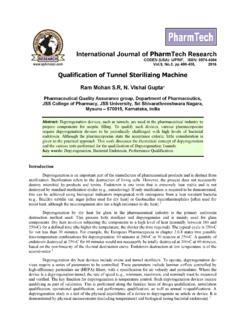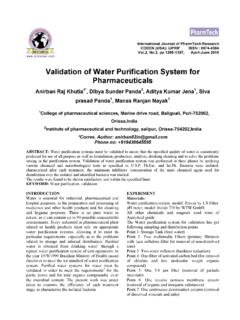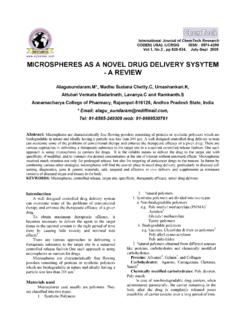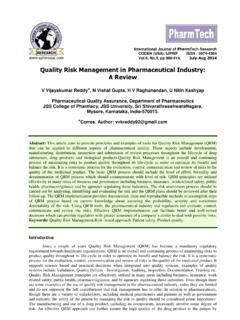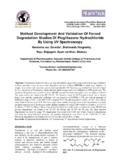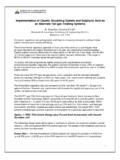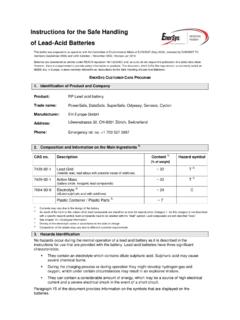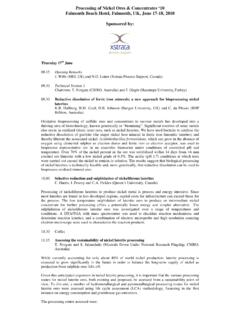Transcription of The Effect of Impurities and Other Factors on the …
1 International Journal of ChemTech Research CODEN( USA): IJCRGG ISSN : 0974-4290 , , pp 1289-1300, April-June 2010 The Effect of Impurities and Other Factors on theCurrent Density in Electro-Chemical ReactorsFelix W. Ntengwe1*, Naison Mazana2, and Fereshteh Samadi11 Copperbelt University, School of Technology, Chemical and Environmental Engineering Department, 4662 Jambo Drive, Riverside, Kitwe, Technology (pty) Ltd, 33 Baker Street, Rosenbank, Johannesburg, South of South Africa, Florida Campus, Christian De Wet, Johannesburg,South Africa.* : or +260212228212 ABSTRACT: The Effect of Impurities , smootheners and Other Factors on the current density in electrochemical reactionswas studied using a parallel plate model in a circular glass reactor heated by a thermostat-controlled water bath. Areduction in current density of 50 mA/cm2 and 40 mA/cm2 was produced for an increase in volumes of thiourea andEDTA of 300 and 100 ml respectively.
2 An increase in distance between electrodes of 3 cm reduced the current densityfrom 34 to 12 mA/cm2 at 60oC. An increase of 41oC produced an increase in current density of 66 mA/cm2 at 2 cmdistance between electrodes while an increase in electrode-active area of 20 cm2 produced a decrease in current densityof 56 mA/cm2 at Amps. The presence of silver and bismuth removed the limiting current-density plateau more so athigher concentrations (> ; > ). A 30 g/L increase in concentration of electrolyte produced an increase incurrent density of 12 mA/cm2 at volts and 26 mA/cm2 at volts. The optimum operating current density wasfound to be dependent on different levels of Factors . Therefore the Factors that affect the current density need to becontrolled if the electrochemical reactor is to be operated without problems of pitting, nodulation and :Concentration;Optimum-current-density;E lectrochemical-reactors; Impurities ; Smootheners; Electrorefining;Electrowinning; current density is the current per unit area ofelectrode1.
3 It is created by the distribution of chargesdue to migration of electrons and ions in the anode-cathode-reactor electrolyte where the metal transfertakes place in electrodes of the first kind (Cu/CuSO4) current distribution on the electrode is not uniformin most practical situations and so is the currentdensity due to a number of Factors . The Factors thatcan affect the current density on the electrode includethe temperature, concentration of electrolyte (Cu2+),distance between electrodes, electrode-active area,presence of Impurities and the use of strongdepolarizing agents and smootheners. The evaluationof current density provides a means of assessing theoptimum current densities that give optimum mass-transfer-process operating conditions3, 4, 5. Suchevaluation can be achieved by investigating the effectsof the stated Factors on the current most electrorefining or electrowinning operations,problems of excessive nodulation, pitting andpassivation are frequently encountered due to incorrectlevels of the Factors that affect the current problems can be solved by evaluating the levelsof such Factors and then determining optimum levels,Felix W.
4 Ntengwe et ChemTech ,2(2)1290which set optimum current densities that can producesmooth deposits on the cathode. It is for this reasonthat this study was carried out using a parallel platemodel in a circular casing forming an electrochemicalreactor. The purpose of the study was to establish theeffects of Impurities , smootheners and Other Factors onthe current density of a parallel-plate electrochemicalsystem that uses the electrodes of the same specific objectives were; (1) To determine thevariations of temperature, distance between electrodes,electrode-active area, and concentration of electrolyte, Impurities and smootheners with the level of currentdensity and (2) To determine the optimum values ofthe Factors that can produce optimum values of currentdensity in order to prevent nodulation, passivity andpitting of the electrodes in electrochemical DENSITY EVALUATIONIn electrolytic reactors, the current density is limiting ifit is independent of potential over a large range.
5 Goodmetal deposit can be obtained through ionic masstransfer if the current densities are maintained atoptimum limiting values in accordance with Faraday sLaw6, 7, 8, 9. Any increase in voltage can affect thecurrent density and therefore power consumption andcapital costs can be decreased due to reduced electrodearea10. This means that the electrode separation,electrode-active area and the temperature would haveto vary in order to optimise the current density andefficiency. Since the contribution of free energy issmall and can be assumed to reduce to unity, thecurrent density (jc, mA/cm2) at the cathode, is afunction of concentration and voltage and inversefunction with temperature (ToC) as given by equation(1) where z is the electrons transferred, F is theFaraday constant (96000 coulombs), kc (s-1) is thereaction rate constant, R is the constant (kJ/kmolK), nis number of electrons and is the potential (volts)across the reactor.
6 At fixed concentration, j varieswith temperature and at fixed T, it varies withconcentration of electrolyte. The current density at theanode can be evaluated from equation (2) where ka (s-1) and ja (mA/cm2) represent the reaction rate constantand current density at the anode respectively.][)(2+-= (1)][)1()(2+--= (2)The rate of reaction is a function of temperature andconcentration of limiting reactant according toArrhenius Law11, 12, 13. The reaction rate is alsodependent on the potential across the reactor. Thevariation of current density with the distance betweenelectrodes, electrode active area and smootheners canbe obtained by data exploration method in which theconstants can be obtained from graphical occurrence of passivity on the electrodes whereelectro-deposition ceases due to high levels of currentand overvoltage is one problem. The Other problem isthat when the concentration of electrolyte drops, thecurrent density may increase resulting in thedevelopment of passivity.
7 These problems can besolved by maintaining the concentration of electrolyteat constant , EQUIPMENT AND METHODSM aterialsThe materials used in the study were sodium chloride(NaCl), thiourea, Ethylene-diamine-tetra-acetic-acid(EDTA) , Gum Arabic (G-Arabic) white crystals,copper sulphate (CuSO4) electrolyte, Krazy glue (K-glue), Bostick glue (B-glue), concentrated sulphuricacid (H2SO4), copper cathodes, crocodile clips,insulation tape, distilled water and the metals bismuthand silver experimental set up was as shown in Figure Ammeter (A) was used to measure the current inseries with the variable resistor (rheostat) and theelectrochemical reactor but parallel to the voltmeter(V). The rheostat was used to adjust the current flowin the circuit. The voltmeter was used to measure theoverpotential (E) across the reactor. The reactor wasassembled using two electrodes; the cathode andanode, placed in a circular-glass casing which washeated by a thermostat-controlled water bath(Ntengwe, 2008)15.
8 The overpotential was used todrive the current through the circuit and to distribute iton the surfaces of electrodes thereby creating thedesired current density which was used to evaluate theeffect of the Factors ; temperature, concentration ofelectrolyte, level of Impurities in solution, electrode-active area, level of smootheners and distance betweenelectrodes on the current density. Mercury in glassthermometer and metre rule was used to counter checkthe temperature controlled by the thermostat in thewater bath and measure electrode W. Ntengwe et ChemTech ,2(2)1291 Figure 1: Experimental apparatus for the measurement of current densityMethodsThe Effect of electrode-active area on the currentdensity was studied using various electrode-activeareas at fixed values of distance between electrodesand voltage in 250 ml samples of electrolyte. Thecurrent density was determined by dividing the level ofcurrent by the electrode-active area.
9 A metre rule wasused to measure the sides of the electrodes dipped inelectrolyte in order to determine the electrode-activearea. Any change in the current density meant thatelectrode-active area had an Effect on the known volume of each of the smootheners, NaCl,thiourea, EDTA, K-glue, B-glue, and G-Arabic wasadded to each of the 250 ml samples before theelectrochemical reaction was conducted in order toestablish the Effect of smootheners on the currentdensity at 2-cm distance between electrodes. Anychange in the level of current density duringelectrochemical reaction would be the Effect ofsmootheners on the current density. Similarly, aknown amount of Impurities of silver and bismuth wasadded to the electrolyte before passing the deviation from the characteristic curve meant thatthe Impurities had an Effect on the current temperature was measured using the mercury-in-glass thermometer.
10 The values of current and currentdensity were obtained at each temperature (24, 39 and60oC) in 250 ml samples. The results were comparedin order to determine the Effect on the current densityat fixed values of electrolyte concentration (5 g/L),electrode-active area (12 cm2) and distance betweenelectrodes (2 cm).The electrolyte concentration was set at differentvalues while the current was recorded at fixed valuesof voltage. The solution of electrolyte was prepared invarying concentrations from g/L to 74 g/L. Theindividual concentrations were , 3, 6, 8, 9, , , and 74 g/L. A voltamograph was taken foreach solution in order to determine the limitingcurrents and hence the current distance between electrodes was set at 1, 2, 3, and4 cm. The temperature, electrolyte concentration andelectrode-active area were set at fixed values of 24oC,39oC, 60oC, 5 g/L and 12 cm2 respectively. Thevoltage was varied in order to produce different levelsof current and hence current density at set-distancesbetween electrodes.
